Pakistan’s celebrated solar energy boom — once hailed as a beacon for clean energy independence — has entered stormy territory. The storm is intensifying mainly for consumers, with frequent policy shifts chiefly protecting the debt-laden grid.
This month, the government has taken a significant step toward a major solar policy overhaul, shifting from net metering to a gross metering system for new rooftop installations.
Under the proposed framework, solar users would sell all of the generated electricity back to the grid at Rs 11.33 per unit—exactly one-third of NEPRA’s base tariff of Rs 34/unit for FY 2025-26.
Earlier, in March, the government had slashed the net metering rate from Rs 27 to Rs 10 for new green meters. Existing net-metering users, however, were allowed to remain under their original Rs 27 per unit buyback arrangement until those agreements conclude.
The drastic reform—aimed at relieving an estimated Rs 103 billion annual burden on non-solar consumers—is heading to the federal cabinet for final approval following stakeholder reviews.
The rationale for these policy shifts stems from mounting concern that net-metering disproportionately favours affluent solar adopters while leaving middling and low-income grid consumers shouldering ballooning fixed costs—including capacity payments to Independent Power Producers.
Under gross metering, separate metering for production and consumption eliminates incentives to oversize systems and also ensures that distribution companies (DISCOs) regain crucial revenue to stabilise the national grid.
The country’s rooftop solar adoption has grown at breakneck speed, fuelled by cheap Chinese panels flooding the market.
Official data show that the net-metering capacity reached 2,813 MW by March 2025, up from virtually nothing a decade ago, with over 300,000 households and businesses now selling excess power back to the grid.
But this revolution is creating a financial “death spiral” for Pakistan’s already debt-laden power sector. As wealthier households and industries reduce dependence on the grid, demand for grid electricity falls.
However, the government remains locked into dollar-indexed capacity payments to Independent Power Producers (IPPs) — fixed costs that don’t shrink when consumption drops.
“Why should we buy power at Rs17 more than the national pool price?” argued Federal Energy Minister Awais Leghari.
“Wealthy households in Karachi, Lahore, and Islamabad avoid fixed costs while poorer consumers shoulder the burden. This is not sustainable.”
The financial crunch
Government estimates suggest that in 2024 alone, Rs159 billion in costs were shifted from solar households to the 40 million remaining grid-dependent consumers. If left unchecked, the figure could hit a staggering Rs4.24 trillion by 2034.
Capacity payments — which already make up two-thirds of an average household bill — are ballooning due to exchange rate volatility and oversupply of generation capacity, much of it from LNG and coal plants financed under sovereign guarantees.
As more consumers disconnect from the grid during daylight hours, distribution companies (DISCOs) lose revenue needed for operations, pushing them further into circular debt, which now stands at dangerous levels.
Consumer backlash
For middle-class solar adopters, the buyback tariff cut feels like a betrayal.
“I invested over Rs2 million expecting to recover my costs in three years,” said Ahmed Raza, an Islamabad homeowner.
“Now I sell power at Rs 10 per unit, but am forced to buy back at Rs 48 plus taxes in the evening. This isn’t renewable energy policy — it’s a trap.”
Small businesses share the frustration.
“We switched to solar because of constant load shedding,” said Shahid Iqbal, a shop owner in Rawalpindi. “Now they’re punishing us for trying to be self-reliant.”
Complaints against solar companies
Adding to consumer woes are mounting complaints against NEPRA-licensed solar installers. Customers accuse companies of overcharging, using substandard inverters and batteries, and failing to honour after-sales service commitments.
According to NEPRA’s consumer affairs division, formal grievances about solar installations have more than doubled in the past year.
Many involve mismatched system sizes — where installers pushed larger systems to earn higher commissions, only for customers to find their sanctioned load limits now capped at 110% under the new policy.
A NEPRA official, speaking on condition of anonymity, admitted, “Our licensing regime needs stricter enforcement. Many of these companies operate with minimal quality checks once the license is granted.”
The IPP conundrum
The government’s headache doesn’t end with domestic consumers. Pakistan’s contracts with IPPs — many signed under the 1994 and 2002 power policies — commit it to paying billions annually for unused capacity.
Attempts to renegotiate have drawn criticism from international lenders, including the International Finance Corporation. The lenders have already warned that it could shake investor confidence.
“We’re paying for electricity we don’t use,” said energy consultant Saadia Qayyum. “Solar is only accelerating the exposure of a system that was already financially broken.”
The road ahead
The government is attempting to slow the solar rush by:
- Cutting the buyback tariff to Rs 10/unit.
- Limiting net-metered capacity to 110% of sanctioned load.
- Imposing a 10% import tax on panels (down from the initially proposed 18%).
- Introducing gross metering to discourage oversized system installation.
Critics argue this risks stalling Pakistan’s progress toward its 2030 goal of 30% renewable generation, while doing little to rectify the structural flaws in the power sector.
“Policy volatility is the enemy of clean energy investment,” warned Federal Petroleum Minister Ali Pervez Malik. “We need stability, not knee-jerk reactions.”
Meanwhile, consumers — whether solar-powered or still dependent on the grid — face a stark reality: rising bills, policy uncertainty, and a power sector that seems perpetually on the brink.
As Haneea Isaad of the Institute for Energy Economics and Financial Analysis put it:
“Solar isn’t the problem. The problem is a grid and tariff structure built for a fossil fuel era, now struggling to adapt.”

























